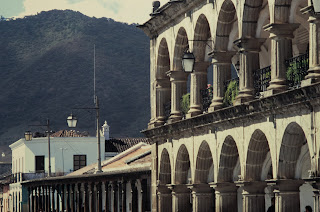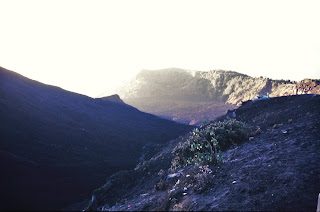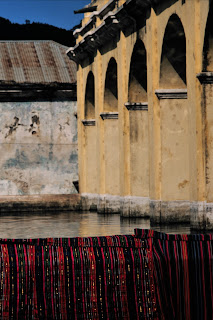Ring of fire
Sometimes the end can be the beginning of a new life, the beginning of something beautiful. Many towns have been abandoned after a natural disaster, war or the depletion of resources. To places like Pompei in Italy, Pagan in Burma or Angkor in Cambodia inhabitants never came back. Only the lifeless ruins remain. The town of Antigua in Guatemala was never completely abandoned. Life in the ruins carried on and the beautiful remains attracted early travellers and later crowds of tourists.
Santa Catalina arch, the only remainder of the former convent
When Antigua was founded by Spanish conquistadors on March 10, 1543 it was already the third capital of Guatemala. The first one had been founded on July 25, 1524 on the site of the Mayan city Kakchikel-Maya, now called Iximche. After Indian uprisings it was moved to a new location in 1527. This second town was destroyed by a Lahar from the neighbouring volcano Agua on September 11, 1541. The site was five kilometres from the present town and is still known today Antigua vieja, the old town. Like its predecessors the new, third town was officially named Santiago de los Caballeros.
The church of La Merced
For more than 200 years, the town was the seat of the military governor of the Spanish colony of Guatemala. This region not only comprised Guatemala but also what are the modern states of Belize, El Salvador, Honduras, Nicaragua, Costa Rica and the mexican state of Chiapas.
Fountain in the courtyard of La Merced
Decorations on the columns
The town is the final resting place of the great Spanish chronicler Bernal Díaz del Castillo (1495-1585). He came to the new world with the first conquistadores and according to his own account fought 119 battles, together with men like Cortes and Alvarado. After he settled in Antigua he wrote his own account of the conquest “true history of the conquest of new Spain and Guatemala”(1568). His remains were interred in one of the churches that was eventually ruined by earthquakes.
The courtyard of San Geronimo
I arrive in the night of December 30th, 1993. I have found two girls to share a taxi from the airport in Guatemala City and we end up in the Posada Doña Angelina, Poniente 33. After almost 30 years it still exists today and although they have done up the rooms to a certain degree it is basically unchanged. There is a central courtyard, which still serves as a parking lot, and part of the rooms are accessible from an archway, where guests can sit and chat.
El Carmen
Regardless the late hour of arrival I still had the energy to look for a bar to have a couple of drinks. I end up in the Picasso cafe, 16 7a Avenida norte. Yes, it also still exists. It was full of foreigners, most in an advanced state of intoxication. However, worst is a local who pretends to be a police man. He gets into some trouble. They kick him out and lock the door. From outside he bangs at the door. When I leave later, I see him fumbling around with his bicycle. Apparently he is too drunk to actually ride it.
The facade of San Geronimo
The next day is new years eve. After dark it gets increasingly uncomfortable outside. Fireworks explode everywhere around me. A guy staggers down the street swinging a meter long coil of Chinese firecrackers around his head. The explosives end up in the crowd. Most of these people are foreigners, I guess the locals cannot even afford the stuff. I seek refuge at a table in a bar and meet Rob, one of the most entertaining and interesting fellow travellers ever.
The interior of San Geronimo
Antigua is very popular for Spanish courses and numerous schools offer courses in combination with a stay in a local family. My original intention was to join a course. However, with the number of foreigners around it would be difficult to actually practice the language. And with all the bars in town I would probably not find the time to stay in my room and study. So I decide to join Rob for a week of cycling in the Guatemalan back country. Corona story number 11 is dedicated to him.
Two of the many historic gates
At its peak in the 1770ies Antigua had a population of some 60,000. The city was laid out in a square pattern around a central square, with streets running north to south and from east to west. Because of the importance of the local capital the colonial administration spared no costs and representative buildings, in particular churches, monasteries and palaces for the Captain General and the Archbishop were constructed. The monasteries also served as hospitals. The monks of San Juan de Dios had founded their hospital and monastery in 1636. They altogether had five which were designated for different groups of people, i.e. for indigenous people, for ecclesiastical personnel and for Spanish and mulattos.
Convent of the Cappuchins
After 1676 a university was founded which started classes for 60 students on January 7, 1681. The first classes given in the new Royal University of San Carlos Borromeo were Canonic law, Medicine, Scholastic theology, Moral theology and Languages
Universidad San Carlos Borromeo
Taking into consideration the number of tourists, all these historic places, which charge a modest entrance fee, are remarkably empty. The shadowy courtyards of the monasteries must have been a real pleasure when the central fountains actually still were working. But even today these ruins are a pleasant refuge from the huzzle and buzzle outside. Other old courtyards now house cafes, where you can quietly sit in the shade, have a drink and read a book, probably not much different from the times when they served for monks, nuns or university students.
Palace of the Captain General...
...at the Plaza Major
Enormous volcanoes, Agua (3766 m), Fuego (3763 m) and Acentenango (3976 m), tower above the old town of Antigua (1601 m). Agua got its name from the Lahar which swept away Antigua viejo and led to the foundation of Antigua proper. Already in the 16th century, shortly after the foundation, earthquakes shook the young town in 1530, 1541, 1565, 1575, 1577 and 1585.
Strong eruptions of Volcán de Fuego started on August 27, 1717. At that time, any natural disaster was considered a divine punishment. The residents of the city asked for help to Santo Cristo of the cathedral and to the Virgen del Socorro. Processions took place until 29 September, the day of San Miguel. After some minor earthquakes there was a strong earthquake at 7 pm. Residents took to the streets and loudly confessed their sins.
The San Miguel earthquake damaged the city considerably, including the palace of the Captain General. Numerous people were dead and injured. The town was partial abandoned and the authorities considered to move the city to a spot less prone to seismic activity. However, the residents strongly opposed and even took to the Royal Palace in protest.
Only few years later, on March 4, 1751, the San Casimiro earthquake destroyed the city once more. However, although the church roof of the Society of Jesus collapsed, the Jesuits rebuilt the temple to one of the most beautiful in the town. Other improvements and new construction took place despite the danger of further destruction.
The exodus came in 1773. The Santa Marta earthquakes destroyed the town to such a degree that, in 1776, the Spanish government ordered the removal of the capital to a safer location, which now is Guatemala City, the modern capital of Guatemala. The gradual forced removal came with a pillage of everything which could be used in the new location. Churches were gutted, ornaments torn from palaces and everything little like pieces of art, beams, doors, locks and furniture moved. Some of the ruins were used by the remaining inhabitants for cattle shelter or storage. More was destroyed in recent earthquakes, such as in 1976. Although the population of the town grew again in the 20th century and had 34,685 inhabitants in 2007 it never reached its former extent and importance.
Volcan Agua above Antigua
Volcan de Fuego is still active today. The volcano produced minor eruptions every 15 to 20 minutes for the last centuries. In 2018 a major eruption caused the death of 159 people. 256 more were missing. End of that year 4000 more people were evacuated from the area because of the ongoing eruptions. September 23rd of 2021 the volcano erupted again. Pictures of ash plumes sent thousand meters into the air went around the world. Some pyroclastic flows raced down the slopes. The eruptions are currently ongoing.
View from the slope of Pacaya
The volcanoes around Antigua are now popular hiking destinations. The ascent requires a two day excursion. Today base camps provide accommodation close to the mountains. Because of ongoing guerilla activity in the area the tour was not recommended back in 1994. However, there is another permanently active volcano in the area.
Compared to Agua, Fuego and Acentenango the Volcan Pacaya is a dwarf with a height of only 2,552 meters. However, until today it is one of the most active of Guatemala’s 38 volcanoes. After being dormant for more than 70 years, Pacaya began erupting regularly in 1961 and has continued to rumble since then. There had been two strong explosions end March, 2021. The volcano displays what is called strombolian activity – short-lived, explosive outbursts of lava – fuelling lava fountains and flows 2 to 3 km down the west flank. Plumes of ash have risen into the air as high as 4,500 meters above sea level from the volcano’s Mackenney summit crater at 2500 meters.
The bus to Pacaya
Pacaya volcano lies about 25 km south of the capital of Guatemala City. The organised tour I have booked involves a bus trip in an old school bus. Around 25 of us are guarded against the guerilla by a guy with a rifle. The last bit of the route rises steeply between coffee plantations and we can sit on the roof and enjoy the view. Behind us a clean, brand-new Mercedes 4x4 with a guy from a German development organisation and his son. They work on projects in Guatemala, and one seems to involve sightseeing at Pacaya.
Waiting for the hike to the summit
We can hear the grumbling of the volcano from far away. Eventually the bus stops and we have to walk. The ascent is not easy. The higher we get, the looser the ash is and with every step the loose mass slides away under the feet. But we are compensated for the effort by the view across the wide plain around Guatemala city. Meanwhile the volcano displays regular eruptions, throwing pieces of lava into the air which come down to the right of the crater. I am getting a bit worried but when I ask the guide he assures me that everything is safe.
Hike to the summit
The higher we climb the colder it gets. Magnus, the son of the german developer, has been up here before. Then, there had been thick fog and they could not find back the way down and had to stay up there in the icy air without any protection. However, the ground is warm and when I sit down on a rock I have the strange sensation of feeling the tremble inside the mountain.
The crater of Pacaya in a moment the fog has lifted
At first there is not much to see. However, the darker it gets the more intense becomes the red glow in the fog. Then the clouds move away. Red-hot rocks are catapulted from the crater into the air high above our heads and end up rolling down the slopes in a fiery trail. We get worried when the fog moves back in and we cannot really see where the projectiles end up. Suddenly a couple of big pieces shatter only about 20 m from us.
Strombolian eruptions of Pacaya
A little panic results. Nobody listens to the advice of the guide to stay or move further up to the second summit to watch the spectacle. The whole group starts running, stumbling and sliding down the slope of the mountain in the poor light of the torches. Back down on the way to the bus everybody is glad to be in safety. At least from here it looks like the ardent mass ejected from the crater now ends up right at the spot where we had been before.
There have been accidents at Pacaya. In 2010 a reporter was killed during an especially violent eruption. However, for the number of visitors there seem to be remarkably few casualities. Even during violent eruptions the area is rarely closed. The guide was right, no trouble.
The next evening we celebrate our heroic excursion with drinks in a bar. Eventually I get up and start walking back the quiet streets to my room. On the sidewalk across the street I notice a well-known figure. A guy slowly limps along towards the pub. I know him. Two friends had left with me on the same flight to Miami. From there the others continued to Mexico, while I went to Guatemala. While two of us were bound for Costa Rica, the third wanted to go back from Managua. In those times without mobile phones it was difficult to keep up a communication while travelling. So we had marked the most attractive guesthouses along the land route from Antigua to San Jose in the most famous guide book, which we all had with us, and had arranged to leave notes there for the others. I had left, but had not yet found any note in Antigua.
M. was glad to meet me. He had just arrived the same day in Antigua. On a beach in Mexico he had had a little accident and dislocated a toe. Fortunately a stranger had been friendly enough to put the toe back into place again. However, walking was still not what it had been and therefore he was limping. We went back to the bar to exchange news about our adventures. M. was a heavy smoker then and together with a good amount of beer to sooze the pain he finished a package of cigarettes, crushed the empty package and threw it to the ground to open a new, full one.
Eventually the bar closed and we were kicked out. Behind us the big gate was noisily locked with a bar like a medieval port. We started to walk when M. started fumbling around in his pockets. He was looking for the address of his guesthouse. He had it written down on his cigarette package, which needless to say, was at the moment probably on its way into a bin at the bar. We went back and banged at the door. Nobody answered. Probably the drunk fellow some days ago had lost his bicycle key in a similar way and could not get in to retrieve it while we were making fun of him inside.
M. could not remember the name of the hotel. The only thing he remembered was that it was in a short dead end street. The entrance of the dead end street was opposite of a naked concrete wall. We started to wander up and down the regular chessboard of Antigua’s cobbled streets in search of the concrete wall. This was heavily handicapped by M.’s hurting toe.
There was nobody in the quiet historic streets and no concrete wall in sight. Eventually we found a policeman. I tried to get together the best of my Spanish and explained the situation, including what we knew about the location of the hotel. And indeed, the policeman knew where the concrete wall and the dead end street were and walked us there. The house was quiet and dark. Only after some banging at the door and shouting a window opened on the first floor and eventually somebody came down to open the door.
After a long period of unrest and civil war tourism was still rather basic in Guatemala in 1994. Although Antigua was full of guesthouses, language schools and tourists, the blackened ruins of Antigua were rather unattended and had a lot of charm. Few of the old houses in the cobbled streets had got a fancy makeover. A comparison in google street view and with recent photos shows that the streets look much fancier now, with freshly and colourfully painted facades and fashionable shops. But what really disappointed me is the state of those ruins, which for me in 1994 where quiet retreats. For conservation, some have got disfiguring shelters. Manicured lawns fill the dusty spaces between the broken walls which have been supported by metal structures. Fences prevent the masses from exploration. Perfectionism has replaced atmosphere, but the support structures will prevent further destruction like in 1976.
Link to the previous post about Guatemala
Woman washing the traditional indian ponchos
Sources
E. Bell, T. Long, Antigua Guatemala, Ninth revised edition, 1993
Previous post about Guatelmala:
















































